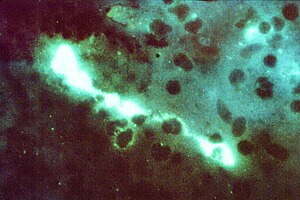Psittacosis
| Psittacosis | |
|---|---|
 |
|
| Direct fluorescent antibody stain of a mouse brain impression smear showing C. psittaci. | |
| Classification and external resources | |
| Specialty |
Infectious medicine Pulmonology |
| ICD-10 | A70 |
| ICD-9-CM | 073 |
| DiseasesDB | 2375 |
| MedlinePlus | 000088 |
| eMedicine | med/1951 |
| Patient UK | Psittacosis |
| MeSH | D009956 |
Psittacosis — also known as parrot fever, and ornithosis — is a zoonotic infectious disease caused by a bacterium called Chlamydophila psittaci and contracted from infected parrots, such as macaws, cockatiels and budgerigars, and pigeons, sparrows, ducks, hens, gulls and many other species of bird. The incidence of infection in canaries and finches is believed to be lower than in psittacine birds.
In certain contexts, the word "psittacosis" is used when the disease is carried by any species of bird belonging to the family Psittacidae, whereas "ornithosis" is used when other birds carry the disease.
In humans, after an incubation period of 5–19 days, the symptoms of the disease range from inapparent illness to systemic illness with severe pneumonia. It presents chiefly as an atypical pneumonia. In the first week of psittacosis the symptoms mimic typhoid fever: prostrating high fevers, joint pains, diarrhea, conjunctivitis, nose bleeds and low level of white blood cells in the blood. Rose spots can appear and these are called Horder's spots.Spleen enlargement is common towards the end of the first week. Diagnosis can be suspected in case of respiratory infection associated with splenomegaly and/or epistaxis. Headache can be so severe that it suggests meningitis and some nuchal rigidity is not unusual. Towards the end of the first week stupor or even coma can result in severe cases.
...
Wikipedia
